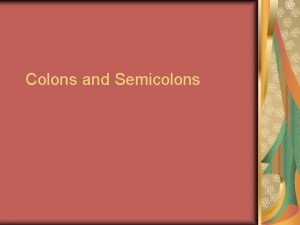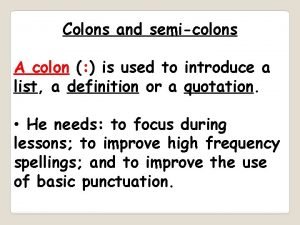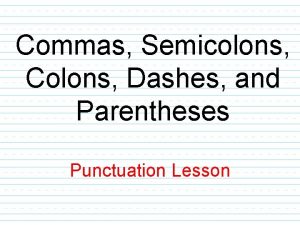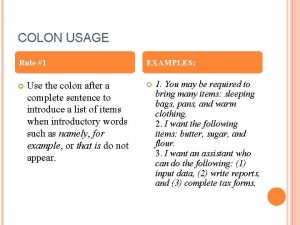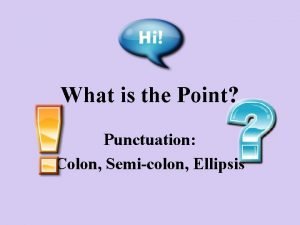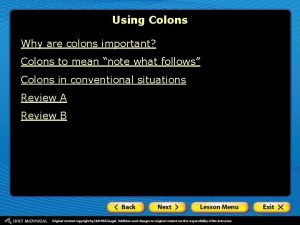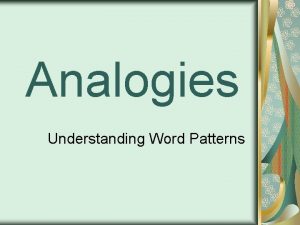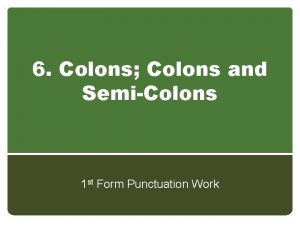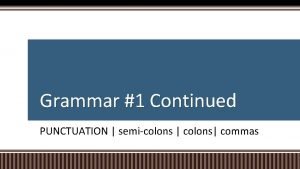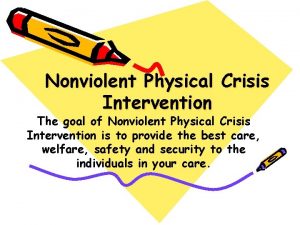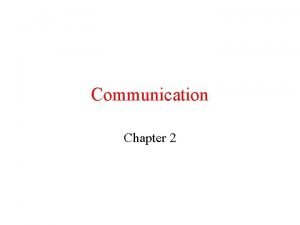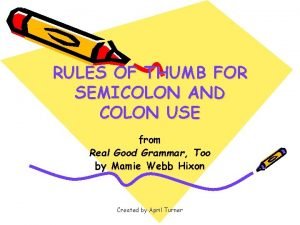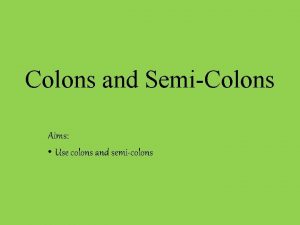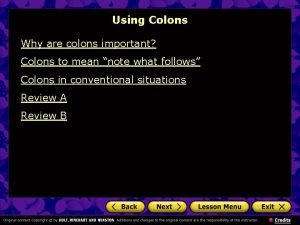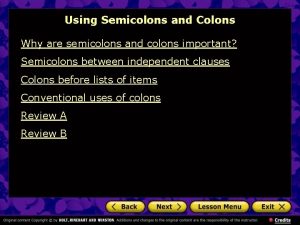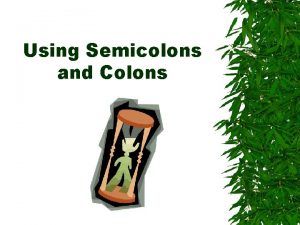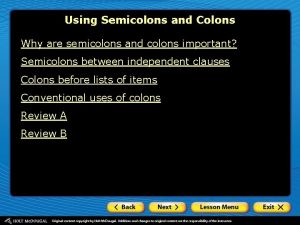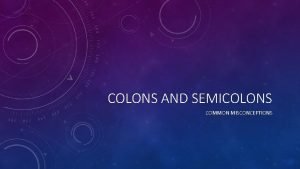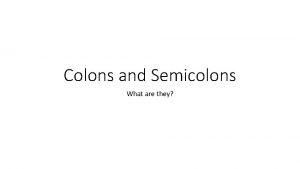Semicolons Colons The reasons for using semicolons and














- Slides: 14

Semicolons & Colons The reasons for using semicolons and where to use them. Nancie Atwell, Lessons that Change Writers. 2002. Portsmouth, NH Heinemann

Reasons For A Semicolon A semicolon is one of the least used but most useful punctuation marks. It shows a close relationship between two statements or sentences. Often, when writers commit a comma splice, it’s because they’ve recognized that the spliced sentences go together meaning-wise, but they don’t know the mark that will make the connection legal. The semicolon fills the bill. It’s stronger than a comma but not as final as a period.

Use a semicolon to: • Join two or more sentences that aren’t connected by a conjunction (e. g. , and, or, because), when you want to show a relationship between them-a closeness in meaning, a cause, or a consequence: EXAMPLE: Stanley wouldn’t tell on us; he was a wimp. I wasn’t worried; after all, Chris was a good driver. I know the conversation had to happen sometime; maybe this was the moment.

Avoid confusion • Avoid confusion in lists that already contain commas: EXAMPLE: We read the poems “Workshop, ” “Marginalia, ” and “Introduction to Poetry” by Billy Collins; “The Osprey, ” “The Summer Day, ” and “Hawk” by Mary Oliver; and “Freedom’s Plow” and “The Negro Speaks of Rivers” by Langston Hughes.

Colons Signal Readers A colon tells a reader to get ready for what comes next: a list, a long quotation, or an explanation. A colon can also cue a reader that what is to come is closely related to what came before. It’s more formal than a dash and stronger than a comma. A colon signals a stop that’s almost as strong as a period.

Use a colon to: • Signal that a list or series is coming: EXAMPLE: I packed everything I needed for a night away from home: nightgown, toothbrush, a good novel, and my autographed photo of Rosie. • Signal that a long quotation is coming: EXAMPLE: Writer Robert Cormier views perseverance and desire as more crucial than talent: “If you have a minimum of talent, but you sit at that typewriter long enough, something will emerge. All I had was this burning desire to be a writer and all these emotions. ”

Explanation is coming: • Signal that an explanation is coming: EXAMPLE: Writing isn’t a social activity but a solo act: writers need to be able to be by themselves, with pen and paper, for long periods of time. Note: If the group of words that comes after the colon, as in example # 3 above, is a complete sentence, you may start it with a capital letter, e. g. , Writing isn’t a social activity but a solo act: Writers need to be able to be by themselves, with pen and paper, for long periods of time.

Comma Splice • As a mark, a comma isn’t strong enough to connect two sentences. The origin of the word comma, comes from a Greek word meaning “little knife”. The Greeks wanted to show that a part of a sentence, a phrase or a clause, had been split but not severed from the whole-a comma’s not a big knife, but a little one.

Comma Splice Continued: • A comma is strong enough to connect groups of words, like phrases and clauses, to sentences, but it’s not strong enough to connect two sentences. When a writer attempts to butt two sentences together by inserting a comma between them, the error is called a comma splice.

Example of Comma Splice • The clouds are gathering in the west, it will rain soon. (Test to determine if comma splice) Can the groups of words on either side of the comma stand alone? Yes, they can stand alone as sentences. So, how do you correct this comma splice?

Corrections • The clouds are gathering in the west. It will rain soon. • The clouds are gathering in the west, and it will rain soon. (This is my least favorite solution. Why stick in extra words, when there’s punctuation that will make the splice legal and keep the voice? ) • The clouds are gathering in the west; it will rain soon. • The clouds are gathering in the west: it will rain soon.

I’m crazy about dogs, English springer spaniels are my favorites. • Possible corrections?

Solutions • I’m crazy about dogs. English springer spaniels are my favorites. • I’m crazy about dogs; English springer spaniels are my favorites. • I’m crazy about dogs, but English springer spaniels are my favorites.

I dreamed, around me the night shifted and settled. • Possible corrections?
 Colons semicolons and dashes
Colons semicolons and dashes Comma vs semicolon list
Comma vs semicolon list When is colon used
When is colon used Interrupting comma examples
Interrupting comma examples When to use a semi colon and colon
When to use a semi colon and colon When is a colon used in a sentence examples
When is a colon used in a sentence examples Colon and semicolon
Colon and semicolon Colon examples
Colon examples Why are colons important
Why are colons important Types of analogies
Types of analogies A colon in a sentence
A colon in a sentence Comma before so
Comma before so Supportive stance reasons
Supportive stance reasons Reasons for using layered protocols
Reasons for using layered protocols Semicolon usage
Semicolon usage

